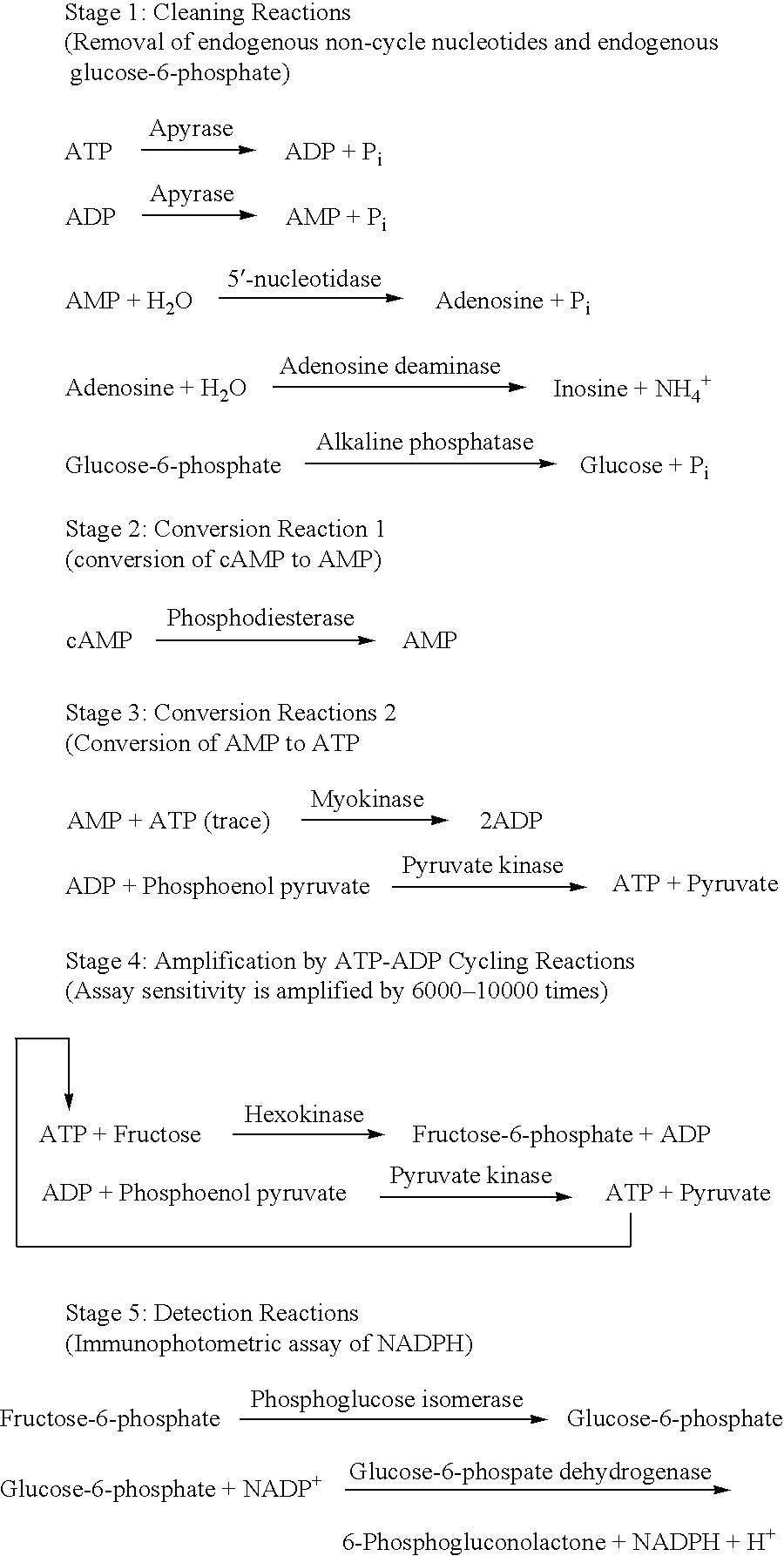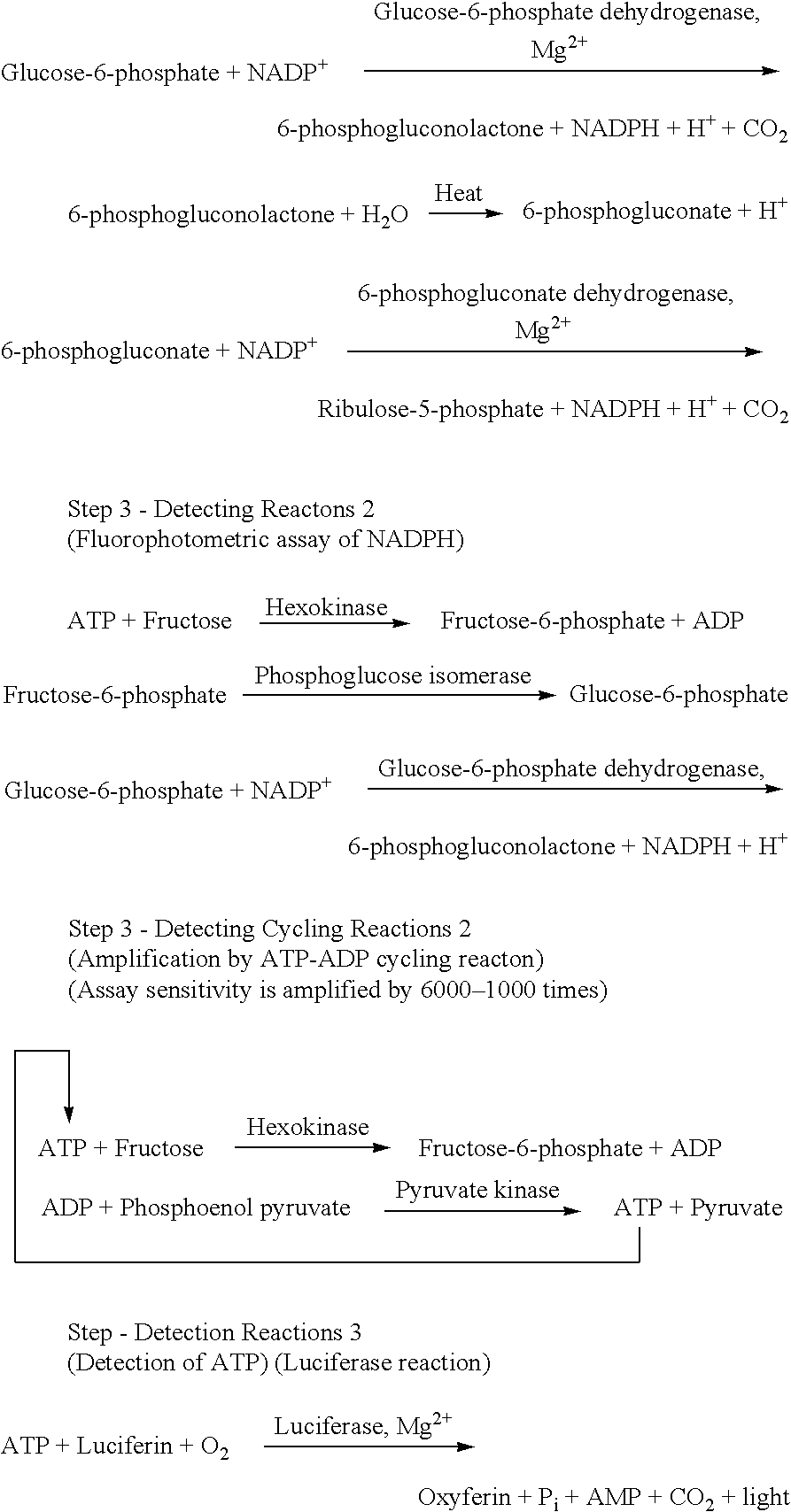Enzymztic fluorometric assay for cAMP and adenylate cyclase
a technology of adenylate cyclase and fluorescence assay, which is applied in the field of enzyme-mediated fluorescence assay of camp and adenylate cyclase, can solve the problems of difficult monitoring accurately changes in tissue level, reliance on dangerously and costly radioactive labeled compounds, and more clear elucidation of the biological role of adenylate cyclase. , to achieve the effect of simple and fas
- Summary
- Abstract
- Description
- Claims
- Application Information
AI Technical Summary
Benefits of technology
Problems solved by technology
Method used
Image
Examples
example 1
[0135] Determination of Cleaning Reaction Period
[0136] A volume of 3 .mu.L of ATP standard (0, 10, 100, 1000 and 10000 pmol / tube) was added into a 10.times.57 Pyrex.RTM. assay tube. While at room temperature, 25 .mu.L of Cleaning Reaction Mixture (100 mM Tris-HCl, pH 8.0; 2 mM MgCl.sub.2; 2 U / mL apyrase; 10 U / mL adenosine deaminase; 40 U / mL alkaline phosphatase) was added to each assay tube. The mixture was incubated at 37.degree. C. for 0, 5, 10, 15 and 20 minutes. Then Step 2--Converting Reactions (Conversion to AMP), Optional Converting Reactions (Conversion to ATP), Step 3--Detecting Cycling Reactions 2 were sequentially carried out and an fluorescence intensity at 340 nm was measured to determine an incubation period when ATP have completely disappeared. The results are shown in FIG. 1. From the results, it was found that an interfering substance, i.e., ATP, substantially disappeared after at most 10 minutes of incubation.
comparing example
[0137] This test was carried out in order to compare Cleaning Reactions of the present invention with that of the cleaning reactions containing 5'-nucleotidase.
[0138] Preparation of a Cleaning Reaction Mixture Containing 5'-nucleotidase
[0139] Tris-HCl (pH 8.0), MgCl.sub.2, 5'-nucleotidase, Apyrase, Adenosine deaminase and Alkaline phosphatase were mixed and to the mixture water was added up to total 25 .mu.L. The cleaning reaction mixture having final concentrations as shown in Table 1 was prepared
1TABLE 1 A cleaning reaction mixture containing 5'-nucleotidase Compound Final Reaction Concentration Tris-HCl pH 8.0 100 mM MgCl.sub.2 2 mM 5'-nucleotidase 2.5 U / mL Apyrase 2 U / mL Adenosine deaminase 10 U / mL Alkaline phosphatase 20 U / mL Water up to a total volume 25 .mu.L
[0140] The cleaning reactions can be shown in the following reaction schemes. 5
[0141] Determination of the Cleaning Reaction Period
[0142] Cleaning reactions were carried out using the cleaning reaction mixture prepared ab...
example 2
[0144] Micro cAMP Measurement in Tissue Cultures with Enzymatic Fluorometric Assay
[0145] (1) Preparation of Samples and Reaction Mixtures
[0146] A. Preparation of Biological Samples
[0147] (Ventricular Myocyte Preparation)
[0148] Isolated ventricular myocytes were obtained from hearts of 1 day-old rats, grown in primary cultures. There were approximately 5 million viable myocardial cells per heart. After plating at a density of approximately 1 million cells per 100 mm, dish cells were grown in minimum essential medium with Hanks balanced salt solution containing 5% bovine calf serum cells. Simpson et al., Cir. Res., 51, 787 (1982). On day 4, the medium was changed. The cultures contained >90% myocardial cells and cell numbers were constant over time. Simpson et al., Cir. Res., 51, 787 (1982); Rocha-Singh et al., J. Clin. Invest., 88, 204 (1991); and Rocha-Singh et al., J. Clin. Invest., 88, 706 (1991)
[0149] Six plates of myocytes were randomized into two groups (n=3 plates / group). The ...
PUM
| Property | Measurement | Unit |
|---|---|---|
| volume | aaaaa | aaaaa |
| pH | aaaaa | aaaaa |
| total volume | aaaaa | aaaaa |
Abstract
Description
Claims
Application Information
 Login to View More
Login to View More - R&D
- Intellectual Property
- Life Sciences
- Materials
- Tech Scout
- Unparalleled Data Quality
- Higher Quality Content
- 60% Fewer Hallucinations
Browse by: Latest US Patents, China's latest patents, Technical Efficacy Thesaurus, Application Domain, Technology Topic, Popular Technical Reports.
© 2025 PatSnap. All rights reserved.Legal|Privacy policy|Modern Slavery Act Transparency Statement|Sitemap|About US| Contact US: help@patsnap.com



